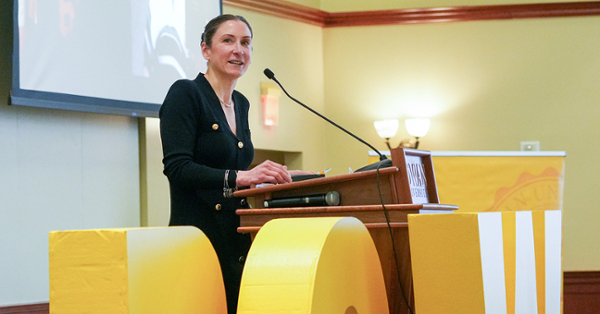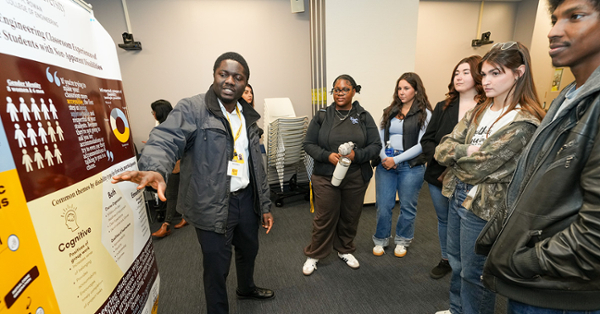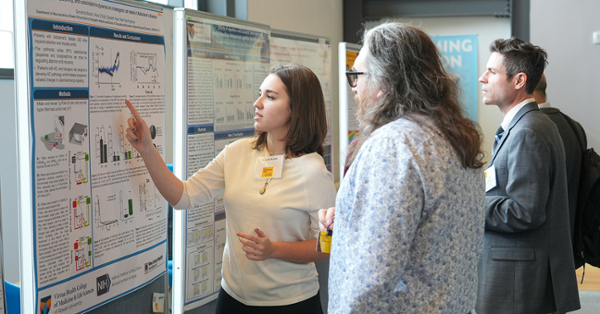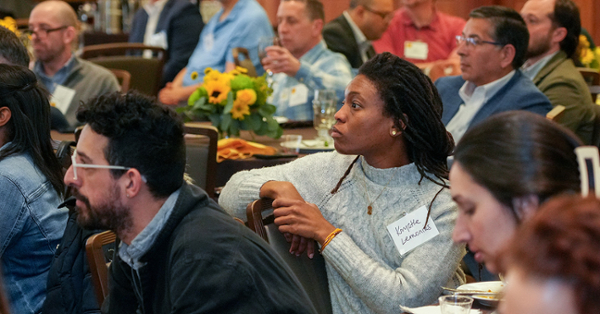Science, creative inquiry celebrated during Rowan Research Day
Science, creative inquiry celebrated during Rowan Research Day
April 2, 2025
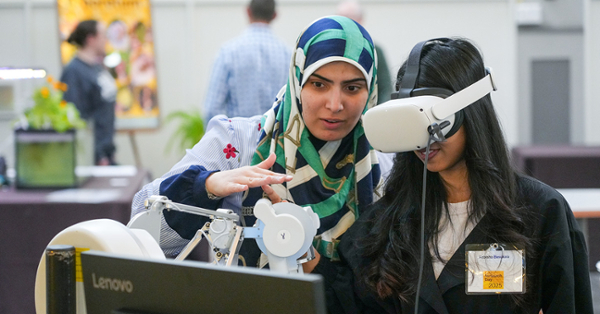
Rowan Research Day highlighted the institution's commitment to advancing research.
Every minute, researchers in New Jersey are developing treatments that could one day save lives—and some of that research is underway at Rowan University.
Research posters, talks and demonstrations filled the University’s student center and its new atrium during Research Day on March 26, highlighting the institution’s commitment to advancing research. In 2024, the University received nearly $75 million in research funding with just over half spent on biomedical research and health sciences.
Science has a profound impact on individuals, said keynote speaker Chrissy Buteas, president and CEO of the HealthCare Institute of New Jersey. The Rowan University alumna pointed to the vital role New Jersey plays in driving new treatments and cures for patients worldwide, “with more scientists and engineers per square mile than anywhere else on Earth.”
“New Jersey accounts for barely 3 percent of the country’s population, yet more than 50 percent of all new FDA-approved drugs are developed or manufactured right here in our state,” said Buteas, whose organization is the state's leading advocate for research-based biopharmaceutical and medical technology companies.
New Jersey’s highly trained workforce is the result of an investment in training and education, Buteas said, particularly through public-private partnerships like those Rowan has championed.
“We need more of these partnerships, bringing industry inside academic labs, connecting students to real-world challenges earlier, and making New Jersey the launchpad for what’s next in global health,” Buteas said.
Mei Wei, vice president for research, said the University is reaching new heights in research, innovation, graduate studies, and publications. In addition to biomedical research, the University received funding in 2024 to support studies on advanced manufacturing and materials; culture and society; artificial intelligence (AI) and digital transformation; and environment and sustainability.
“Our faculty and student researchers, the backbone of our research community, continue to push boundaries and make lasting impacts in their fields,” Wei said.
Rowan Research Day attendees also heard from the University’s experts on topics ranging from artificial intelligence to a Romanian poet whose regime-challenging work has been documented by a Rowan filmmaker.
Nidhal C. Bouaynaya, associate vice president for AI, explained how Large Language Models (or LLMs) are fundamentally changing modern society, while offering caution about the technology’s inherent limitations and continuing need for human input.
“It takes a village to raise responsible AI,” Bouaynaya said. “Trustworthy AI is a human mission. There’s incredible promise, but big pitfalls.”
Climate scientist Andra Garner discussed how rapidly warming oceans are fueling hurricane development, increasing the probability of catastrophic damage along the East Coast. Her talk, “Hope Amidst Storms of Change,” offered a note of optimism: “We know we’re the problem, so we can be the solution,” Garner said.
Chemist James Grinias explained his lab’s goal to develop new techniques that will speed and improve testing using a miniaturized version of a chemistry lab, allowing for faster results in the field. Such vital research is funded by federal agencies, such as the National Institutes of Health and the Department of Defense, he stressed.
Public historian Jennifer Janofsky detailed her team’s work to document a mass burial site at nearby Red Bank Battlefield in Gloucester County. DNA results of remains found at the site will be determined soon, allowing researchers to begin connecting Revolutionary War-era Hessian soldiers to their relatives in Germany.
Business scholar Tony Lin discussed AI’s impact on the employment market and urged his audience to learn how to collaborate with the tool. Given employers’ embrace of AI’s promise, he said, professionals who know how to use AI will one day replace those who don’t.
Documentary filmmaker Diana Nicolae shared a trailer for her new film, “Between Silence and Sin,” about Romanian poet Ana Blandiana, who wrote in protest against the communist regime. Nicolae gained access to 100 hours of video footage from the country’s archives, which she said was a “very difficult process.”
Director Lane Savadove ended the afternoon with a discussion about his international efforts to stage the ancient Hindu epic, The Ramayana. In 1996, he and collaborators in Indonesia and the United States began efforts to bring the work to new audiences. They persisted for nearly three decades despite disruptions and delays.
The cross-cultural result was staged at the Philadelphia Navy Yard in June 2024 by EgoPo Classic Theater through a collaboration with Papermoon Puppet Theatre and Kalanari Movement Theatre—a testament to the passion and perseverance of its makers.
Research posters, talks and demonstrations filled the University’s student center and its new atrium during Research Day on March 26, highlighting the institution’s commitment to advancing research. In 2024, the University received nearly $75 million in research funding with just over half spent on biomedical research and health sciences.
Science has a profound impact on individuals, said keynote speaker Chrissy Buteas, president and CEO of the HealthCare Institute of New Jersey. The Rowan University alumna pointed to the vital role New Jersey plays in driving new treatments and cures for patients worldwide, “with more scientists and engineers per square mile than anywhere else on Earth.”
“New Jersey accounts for barely 3 percent of the country’s population, yet more than 50 percent of all new FDA-approved drugs are developed or manufactured right here in our state,” said Buteas, whose organization is the state's leading advocate for research-based biopharmaceutical and medical technology companies.
New Jersey’s highly trained workforce is the result of an investment in training and education, Buteas said, particularly through public-private partnerships like those Rowan has championed.
“We need more of these partnerships, bringing industry inside academic labs, connecting students to real-world challenges earlier, and making New Jersey the launchpad for what’s next in global health,” Buteas said.
Mei Wei, vice president for research, said the University is reaching new heights in research, innovation, graduate studies, and publications. In addition to biomedical research, the University received funding in 2024 to support studies on advanced manufacturing and materials; culture and society; artificial intelligence (AI) and digital transformation; and environment and sustainability.
“Our faculty and student researchers, the backbone of our research community, continue to push boundaries and make lasting impacts in their fields,” Wei said.
Rowan Research Day attendees also heard from the University’s experts on topics ranging from artificial intelligence to a Romanian poet whose regime-challenging work has been documented by a Rowan filmmaker.
Nidhal C. Bouaynaya, associate vice president for AI, explained how Large Language Models (or LLMs) are fundamentally changing modern society, while offering caution about the technology’s inherent limitations and continuing need for human input.
“It takes a village to raise responsible AI,” Bouaynaya said. “Trustworthy AI is a human mission. There’s incredible promise, but big pitfalls.”
Climate scientist Andra Garner discussed how rapidly warming oceans are fueling hurricane development, increasing the probability of catastrophic damage along the East Coast. Her talk, “Hope Amidst Storms of Change,” offered a note of optimism: “We know we’re the problem, so we can be the solution,” Garner said.
Chemist James Grinias explained his lab’s goal to develop new techniques that will speed and improve testing using a miniaturized version of a chemistry lab, allowing for faster results in the field. Such vital research is funded by federal agencies, such as the National Institutes of Health and the Department of Defense, he stressed.
Public historian Jennifer Janofsky detailed her team’s work to document a mass burial site at nearby Red Bank Battlefield in Gloucester County. DNA results of remains found at the site will be determined soon, allowing researchers to begin connecting Revolutionary War-era Hessian soldiers to their relatives in Germany.
Business scholar Tony Lin discussed AI’s impact on the employment market and urged his audience to learn how to collaborate with the tool. Given employers’ embrace of AI’s promise, he said, professionals who know how to use AI will one day replace those who don’t.
Documentary filmmaker Diana Nicolae shared a trailer for her new film, “Between Silence and Sin,” about Romanian poet Ana Blandiana, who wrote in protest against the communist regime. Nicolae gained access to 100 hours of video footage from the country’s archives, which she said was a “very difficult process.”
Director Lane Savadove ended the afternoon with a discussion about his international efforts to stage the ancient Hindu epic, The Ramayana. In 1996, he and collaborators in Indonesia and the United States began efforts to bring the work to new audiences. They persisted for nearly three decades despite disruptions and delays.
The cross-cultural result was staged at the Philadelphia Navy Yard in June 2024 by EgoPo Classic Theater through a collaboration with Papermoon Puppet Theatre and Kalanari Movement Theatre—a testament to the passion and perseverance of its makers.
